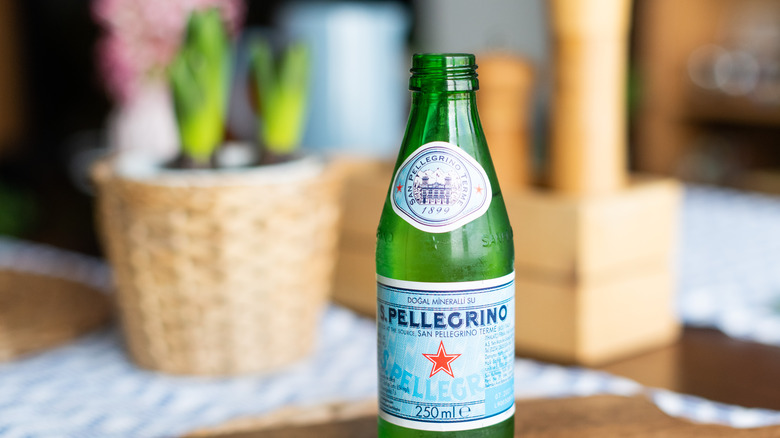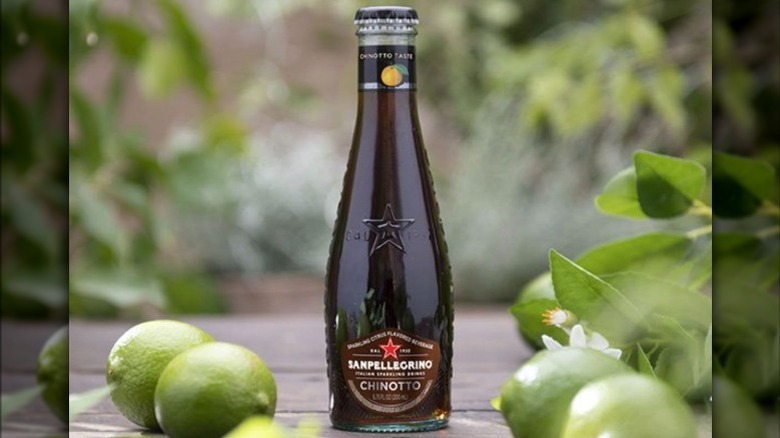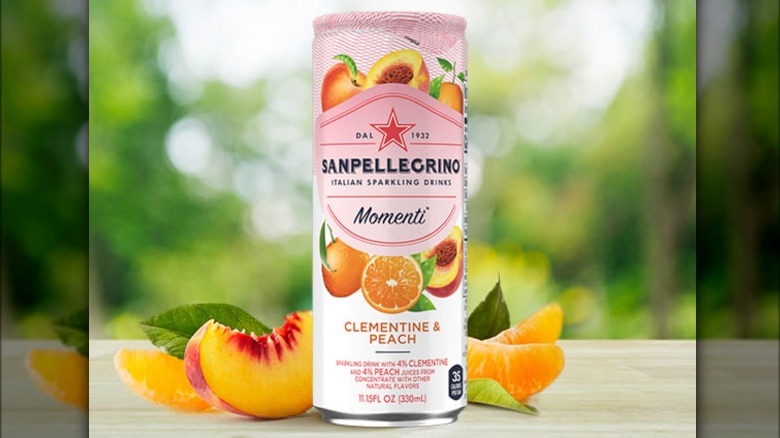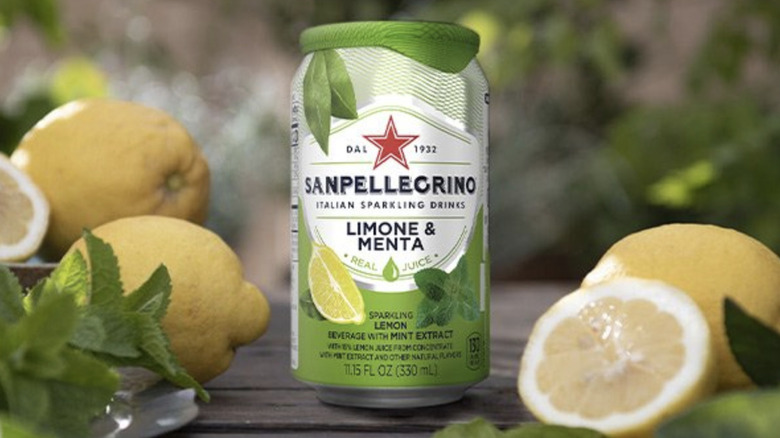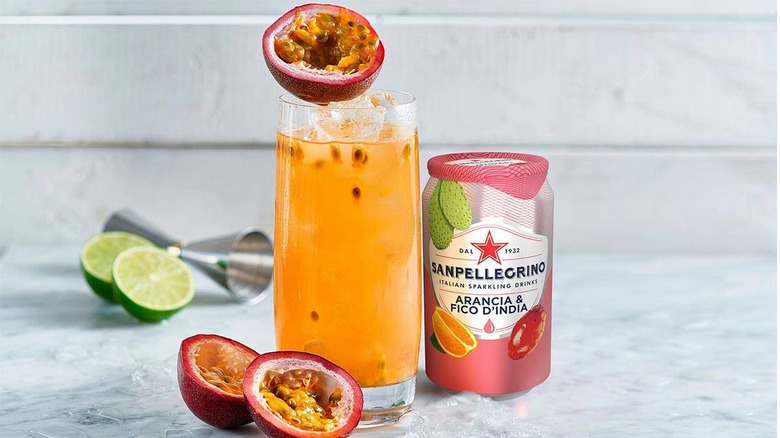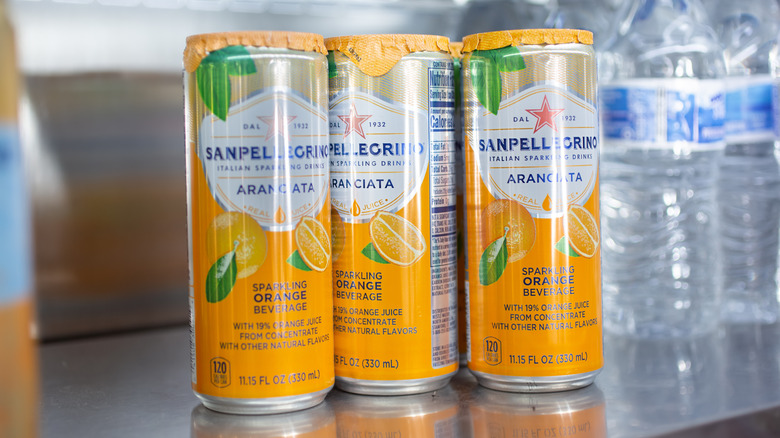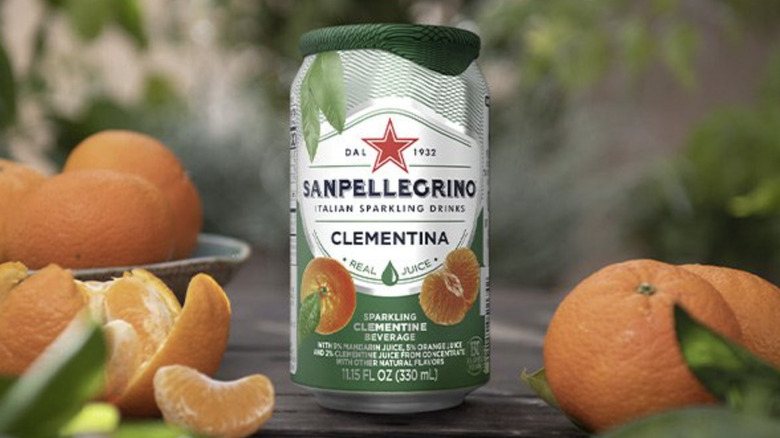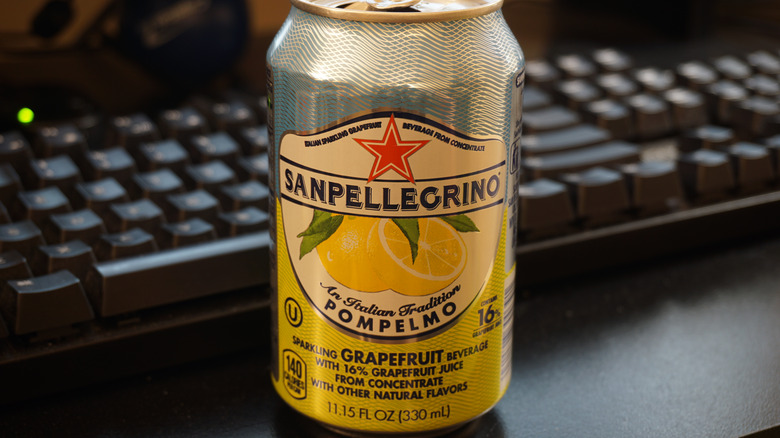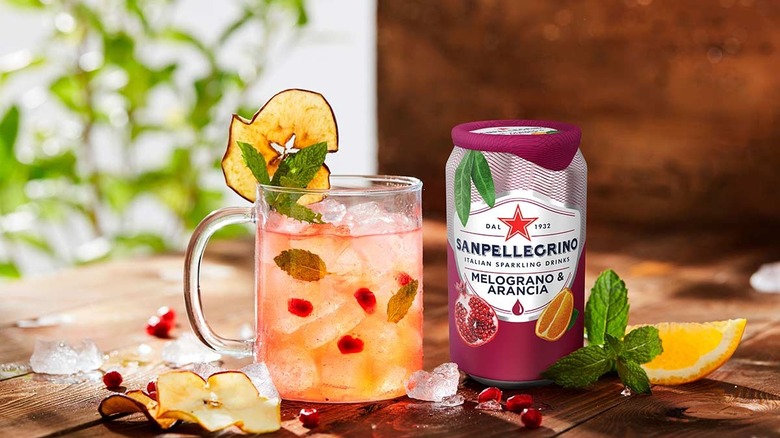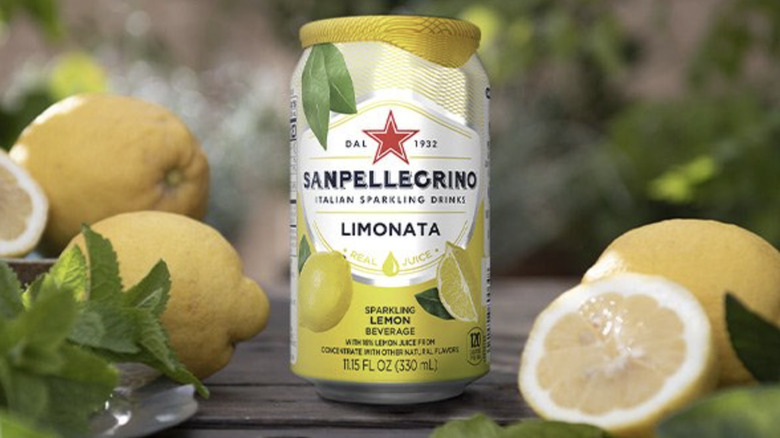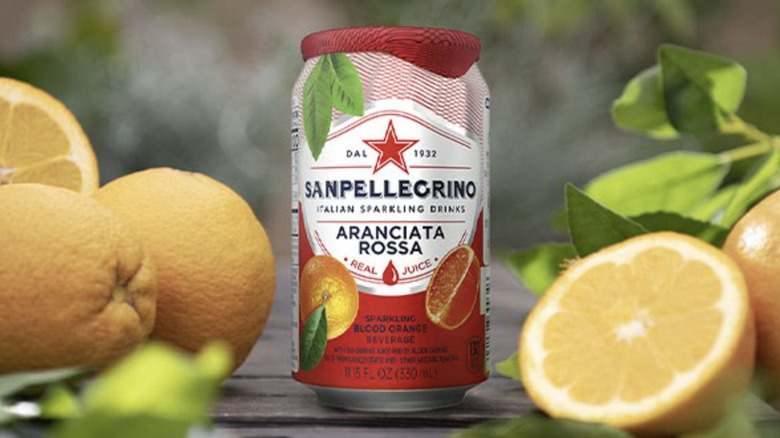10 Best San Pellegrino Flavors Ranked
If you're 30 years old, and you just so happen to drink San Pellegrino mineral water that was bottled this year, you'd be drinking water that's the same age as you. Founded in 1899 in Bergamo, Italy, and manufactured by Nestlé, San Pellegrino sources all of its water from the Alps. Hence, according to Forbes, by the time you're having that refreshing sip, it has collected all its minerals while slowly drizzling down the mountain slopes for three decades. On the business end of things, the esteemed mineral water company celebrated its 120th year in 2019 and broke ground on a new factory designed by the New York-based architecture firm, Bjarke Ingels Group.
While San Pellegrino fans await the "Factory of the Future"s opening in 2022 (via Time Out) which will feature an interactive Experience Lab for visitors, you can still bathe in the San Pellegrino QC Terme Spa's thermal baths. It seems this is not the only change behind the premium mineral water company's curtains, because it recently also released a new-look packaging for its flavored canned drinks, sans its signature foil overlid (via The Drum). Nevertheless, it's still what's inside that counts, right? This is why we've ranked the best flavors for you to see how your favorite fares.
10. Chinotto
Until as recently as the 1990s, ordering a chinotto might have left your bartender puzzled, per The Grand Wine Tour. Described as sweet, with a bit of bitterness and an aftertaste that one can't necessarily pin down, it remains somewhat unclear as to who actually invented chinotto soda. San Pellegrino is among those who claim to have brought it into the soda market, though Neri catapulted its visibility when it launched its advertising campaign of Chinotto as the more patriotic version of Coca-Cola in Italy.
The argument over its creation may never be settled, but long before the soda was conceived, chinotto was just a citrus fruit growing from a beautiful tree with white flowers. It's now cultivated in the Italian cities of Calabria, Sicily, Tuscany, and Liguria, where it was brought in from China during the 1500s by a sailor. One thing for sure is that this is a drink that comes with a history, and as San Pellegrino says, an intense flavor. The consequence of that is that the assertiveness of this specific flavor may not translate well if you're entirely unfamiliar with it.
9. Clementine & Peach
With an equal 4% of both clementine and peach concentrate juices in the Momenti Clementine & Peach, this sparkling drink feels like a silent nod to an age-old Italian tradition: peaches in wine. According to Italian Traditions, during the summer months, peaches are often placed in red wine and left to cool and mix in the refrigerator. The practice, which originated in Southern Italy, seems to have been influenced by the Spanish — who popularized sangria — and continues to be passed down across generations.
Though red wine is commonly used, in some regions, people drinkpeaches and white wine, lemon and/or orange juice. If you're not a wine drinker, you're watching your calories, or you're just eager for a cool summer drink, San Pellegrino created this citrusy flavor with no artificial sweeteners that contains less than 40 calories. This is a good enough Momenti to be on this list, but Pellegrino's low-calorie line can only compete so much with the full-sugar drinks. Nevertheless, it's a whimsical mix.
8. Limone & Menta
From drinks and desserts to sauces and dips, lemon and mint are the iconic duo that keeps on giving. Lemon water alone has been associated with countless myths; it has been claimed to alkalize, cleanse, and detox the body, amongst other purported benefits (via Medical News Today). However, these have either been discounted or not been backed up by scientific research. Lemons do, however, contain vitamin C, an antioxidant that acts as a barrier against cell damage.
Pair this with mint, and you have the added benefits of its nutrient profile, which has been found to aid digestion, improve of irritable bowel syndrome, assist brain function, and give you fresher smelling breath, amongst other benefits (via Healthline). You've probably already had your fair share of forgotten lemon slices and mint leaves in your water bottle, but San Pellegrino's mix of 16% lemon juice and peppermint extract in this drink is bound to feel like a fancy treat for your tastebuds. Limone & Menta is easy to add to your diet, perhaps too easy. Since you can get lemon and mint-infused water that's not sweetened with 130 calories of sugar, you might want to save this beverage for special occasions.
7. Arancia & Fico D'India
Keen for a little cactus in your drink? This is just the one for you. Now, orange juice is a staple. Many people cannot imagine a breakfast spread without it. But prickly pear? That's what really makes this flavor. According to Britannica, prickly pears are part of the Opuntia family, a flat-stemmed cacti that is indigenous to the Western Hemisphere and is of high importance in several sub- and tropical countries. In Italy, Sicilian prickly pears were imported during the 15th century. The fruit has grown so much in popularity that there are even annual festivals dedicated to it during the months of September through November (via Visit Sicily).
Per San Pellegrino, this flavor contains 10% and 6% orange and prickly pear juice in concentrate respectively. It pairs well with Panzanella, a Tuscan chopped salad that typically contains toasted day-old bread, onions, and tomatoes, and is dressed with olive oil and vinegar. You can of course, customize it, or simply make use of this delicious panzanella recipe. Or otherwise, you can pair the drink with fish kabob. If you like prickly pear enough to know about the festivals, this is probably for you, but cactus fruit might be an acquired taste for some.
6. Aranciata
It's becoming increasingly obvious as we progress through this list that there's a bias toward citrus fruits. As it turns out, Italy is quite big on citrus. Taste Atlas has even outlined some of the country's most popular citrus fruits. Among the oranges, Arancia di Ribera and Arancia Rossa di Sicilia are included. Arancia di Ribera's sweetness makes them for juices, smoothies, and being featured as a surprise addition in traditional Sicilian dishes. Arancia Rossa di Sicilia, on the other hand, is distinctly tart and commonly referred to as the "blood orange of Sicily."
As previously noted, it's nearly impossible to conjure an image of a breakfast buffet without the customary jug of orange juice. Whether as a breakfast drink, cake, dressing, or sauce, orange remains a versatile ingredient. Containing 19% orange juice from concentrate, the San Pellegrino Aranciata is a classic drink that dates all the way back to 1932. And if you want an extra bit of dazzle, a slice of orange or some juniper berries are recommended as garnishes. While Arancia di Ribera can be used as a surprise in dishes, this flavor is not surprising. It is stable, expected, and exactly what you know you can lean on when you aren't in the mood to think too hard about an alternative.
5. Clementina
According to Toast Magazine, the origins of clementines are somewhat unclear, with various claims that they came from Algeria, China, Mediterannean Europe, or the United States. Regardless of this uncertainty, for some, clementines are associated with Christmas stockings. Underlying that nostalgia is a heartfelt story of a Greek bishop (on whom Santa Claus is based) who dropped three bags of gold down a poor man's chimney who, by virtue of his status, could not find suitors for his daughters. Clementines are a symbol of generosity and the gold that fell into each of the daughter's stockings.
With a 9% mandarin, 5% orange, and 2% clementine blend of citrus, this San Pellegrino flavor is delicate and a recommended pairing mate for tigella with cold cuts or cacciucco fish soup. You may not believe in Santa Claus or even folklore around the origin of fruits, but we all believe in generosity. It will be pleasant to remember the legend the next time you enjoy a bottle of this. Similar to the Aranciata, this is a straightforward flavor, although not generic, and it will make most people happy.
4. Pompelmo
Mentioned among "the healthiest summer fruit" by Greatist, grapefruit boasts a distinct flavor. But did you know that just half of a single one can give you up to 70% of your daily recommended vitamin C intake? Gasp, you know what that means, right? Antioxidants for the win. Vitamin C is also associated with improved immune functioning and healthier skin and bones because it promotes collagen production.
According to BBC Good Food, grapefruits are so named because they grow in little bunches that resemble those of grapes. Ironically, they are also the largest citrus fruits and can get to about 18 centimeters in diameter. As for the San Pellegrino Pompelmo, this drink is not only large in flavor, it also "dances across your tongue," and according to one Drinkable review, tastes undeniably natural. It can also be paired with fried polenta and crocché, a Sicilian fried snack that contains mashed potatoes, eggs, cheese, and herbs.
3. Melograno & Arancia
While citrus is quite popular in contemporary Italian society, you may be surprised to know that to the ancient Romans, it was a symbol of status. According to Atlas Obscura, citrons and lemons were for a long time the only citrus fruits known to ancient Romans. Citrons in particular were not even necessarily tasty; they were more rind than flesh, and hardly had any flavor or juice. Nevertheless, they were found useful for taming bad breath and repelling moths. However the 15th and 19th centuries when oranges and mandarins where introduced to Western Europe, citrus fruits were no longer the status symbols they were in ancient times.
That being said, with an 11% orange and 5% pomegranate mix of juice concentrates, this San Pellegrino blend is elegant, playful, and can be paired with tuna tartare and a zesty orange salad. It certainly feels fancy, but now you don't need to be too concerned about climbing countless ladders of status symbolism to simply enjoy a pretty and refreshing citrus beverage. All you need to do is buy a can of this San Pellegrino variety to get your classic orange flavor with a gorgeous twist.
2. Limonata
Of all the most popular citrus fruit in Italy, lemons feature most prominently. Among these are: Limone di Rocca Imperiale, Limone Interdonato Messina, Limone dell'Etna, Limone di Siracusa and Limone Costa d'Amalfi. Each of these have a distinct characteristics that set them apart from the others. For instance, Limone di Rocca Imperiale boasts a 30% juice yield, Limone Interdonato Messina is a lemon and citron crossbreed, Limone dell'Etna gets its fragrance from being grown in volcanic soil, Limone di Siracusa can be harvested all year, and Limone Costa d'Amalfi is so sweet that it can be eaten out of hand like an orange (via Taste Atlas).
This might all pique your interest about which lemons are used in this one. We're not sure, but nevertheless, the San Pellegrino Limonata packs a zesty punch of 16% lemon juice from concentrate. You should enjoy this drink cold — without ice — and you can add fresh raspberries, mint and star anise if you're after an more elevated finish. If you're feeling expemental, you can even play with Greatist's recreation of the Limonata and see how it measures against the original. This is a flavor that holds its power with elegance and simplicity, and given that it specifically needs no ice? It evidently knows how to hold its own.
1. Aranciata Rossa
If you've wondered just how much adoration San Pellegrino Aranciata Rossa boasts, in 2018, the introduction of a sugar tax in Britain led to the Limonata and Aranciata Rossa's sugar content being reduced to less than 5g per 100ml. At the time, per Lad Bible, consumers were reportedly so unimpressed by the changes that many insisted that they would rather have the price increased to accommodate the higher tax bill its manufacturer would have to foot. It seems the customer is indeed always right, because currently, a 330ml can of Aranciata Rossa contains 29g of sugar.
This means you get to enjoy your premium flavored water with a 16% orange and 3% blood orange blend, a lot of sugar, and an orange or rosemary sprig garnish if you wish. To make an occasion of it, the recommended food pairings are friselle — a double-baked bread from Puglia — or scacciata siciliana — a Sicilian street food made of bread dough stuffed with various fillings. This is a beautiful play on a flavor that is trusted, stable, but in many ways, classic. It's quintessentially Italian and tastes like sunshine in a can.
